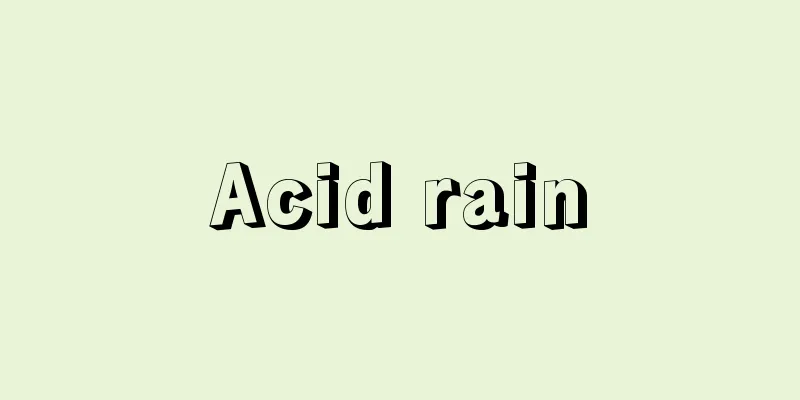Acid rain

|
Rain with a high acidity. It is generally called acid rain, but since it can also be snowfall, it would be more accurate to call it acid precipitation. [Hiroyuki Yokota] Characteristics and causes of acid rainDistilled water has a pH (hydrogen ion concentration) of 7.0, making it neutral, but because the Earth's atmosphere contains carbon dioxide CO2 , rain that falls through the atmosphere generally has an acidity of about 5.6. Rain with a lower pH value and a stronger acidity is called acid rain. It is said to be caused when air pollutants such as sulfur oxides (SOx) and nitrogen oxides (NOx) turn into sulfuric acid and nitric acid in the atmosphere and are then incorporated into raindrops. It can also fall to the ground not only as rain, but also as part of fog or snow (collectively known as wet deposition), or in the form of dry particles or gas (dry deposition). The air pollutants that cause acid rain are emitted from factories and automobiles that use fossil fuels such as gasoline, heavy oil, and coal. However, the acid rain that results from these can fall thousands of kilometers away from the source. As a result, acid rain falls in Northern Europe, far from the industrial areas of the UK and Germany (the impact is greatest when air currents are from the south or southwest), and a wide-area effort that transcends national borders is needed. [Hiroyuki Yokota] History of Acid RainThe damage caused by acid rain began to appear as industrialization rapidly progressed in the mid-19th century in Britain and other countries. It was British chemist Robert A. Smith (1817-1884) who first pointed this out in 1872. In that same year, he pointed out that rain was acidic in his paper "The Smog of Manchester". However, it was not until 1967 that Swedish soil scientist Svante Oden explained acid rain based on actual data. After extensively investigating the distribution of acid rain, he determined that it was caused by sulfur dioxide gas and nitrogen oxides transported from far away. In this paper, Oden warned that acid rain would cause great damage to water quality, soil, forests, and buildings in the future, and that it would "become a chemical warfare for mankind". For this achievement, Oden is now known as the "father of understanding acid rain". [Nemoto Junkichi] Damage situation overseasWhen it falls to the ground, it causes a variety of damage. First, it acidifies the water in lakes and rivers, and harmful metals leach from the lake bottoms, destroying the habitat of fish and other creatures. It also acidifies the soil, causing forests to decline. Or it falls directly on trees, causing them to die. In addition to these effects on the environment, there are also concerns about damage to cultural properties, such as marble and other stone statues, which will dissolve in the acid rain. Acid rain has caused widespread pollution in Europe, mainly in Northern Europe, as well as in the northeastern United States, eastern Canada, and China. For example, in Norway, the pH value has decreased by 0.5 to 1.0 (meaning a 7 to 10-fold increase in acidity), causing over 1,500 lakes to lose their fish. The Adirondack Park in the United States, located east of Lake Ontario, is hundreds of kilometers away from the pollution source, but acid rain has caused frogs to disappear from the park's crystal clear lakes, and previously abundant fish such as trout, perch, and pike have disappeared. In addition, in the Black Forest in Germany, near the source of the Danube River, the pH dropped from 5 to 6 to 3.2 over a 10-year period, and at one point recorded 2.8, the same as that of lemon juice. As a result, evergreen coniferous trees stopped growing, cavities appeared in the center of the trunks, and the gruesome sight of diseased coniferous trees being cut down can be seen everywhere. In Sweden, 15,000 of the 85,000 lakes and ponds have become acidic, and 4,500 of those have lost fish, dealing a major blow to ecosystems across the country. Damage such as the accelerated corrosion of cultural properties made of stone and bronze has also been reported. Even in China, where rapid industrialization continues, acid rain is feared as an "airborne demon," and in industrial cities such as Chongqing, the iron used in buildings is corroding rapidly, and forests in various regions are also being damaged. Since acid rain is a cross-border issue in Europe and other places, the regulations of a single country are insufficient to prevent it, and it is a serious problem that requires international cooperation. [Hiroyuki Yokota] Damage situation in JapanAcid rain was first observed in Japan in the 1950s, when a pH of 2 was recorded in Yokkaichi City, Mie Prefecture. Then, in July 1974, acid rain fell in the inland Kanto region, including Gunma Prefecture, Saitama Prefecture, and Tochigi Prefecture, causing damage to tens of thousands of people who complained of eye irritation and skin pain. Furthermore, on June 26, 1981, Maebashi City, Gunma Prefecture, recorded the highest acid rain value ever observed in the Kanto region, with a pH of 2.88 after just 1 millimeter of rain had started to fall. At that time, other values observed included pH 3.01 in Honjo City, Saitama Prefecture, pH 3.28 in Kumagaya City, and pH 3.10 in Kawasaki City, Kanagawa Prefecture. An examination of the atmospheric pressure distribution during the acid rain in June 1981 revealed that the rainy season front was stationary along the southern coast of Honshu, with the cloud base measuring 200 meters in Tokyo and 300 meters in Maebashi, and the cloud thickness measuring approximately 2 kilometers. It is believed that exhaust gases from the chimneys in the Keihin and Keiyo areas entered this cloud layer, reacting with the water to form nitric acid and sulfuric acid, which were then transported north in a concentrated state. The Ministry of the Environment (formerly the Environment Agency) continues to investigate the state of acid rain in Japan, and according to the third investigation from 1993 to 1997, the national average pH of acid rain during that period was recorded at 4.8 to 4.9. This figure has hardly changed since the first investigation, and no clear impact on the ecosystem has been made clear. However, the acidity is roughly the same as that in Europe and the US, where serious damage has already occurred, and there is no guarantee that damage will not occur in the future, so there is a need for continued observation and investigation of the impact on soil, vegetation, etc. [Hiroyuki Yokota] countermeasureAs this is environmental destruction that crosses national borders, international efforts are essential, and the Convention on Long-Range Transboundary Air Pollution was concluded in 1979, primarily in Europe. The subsequent Helsinki Protocol (1985) stipulated a minimum 30% reduction in SOx emissions by 1993 compared to 1980 levels, and the Sofia Protocol (1988) further stipulated a freeze on NOx emissions at 1987 levels. Measures to combat acid rain have been implemented in each of the member countries. In addition, the influence of air pollutants from mainland China has been pointed out as one of the causes of acid rain in Japan, so in addition to measures within Japan, assistance for pollution prevention on the mainland is also of great significance. At the same time, Japan is working with neighboring Asian countries to advance the "East Asia Acid Rain Monitoring Network Initiative" in order to grasp the actual state of acid rain. [Hiroyuki Yokota] "Acid Rain" by Hiroyuki Ishihara (Iwanami Shinsho) [Reference items] | | | | | |Source: Shogakukan Encyclopedia Nipponica About Encyclopedia Nipponica Information | Legend |
|
酸性度の強い雨。一般に酸性雨といわれるが、降雪の場合も含まれるので、酸性降水というほうがより正確である。 [横田弘幸] 酸性雨の性状と原因蒸留水はph(ペーハー)(水素イオン濃度)7.0で中性だが、地球の大気には二酸化炭素CO2が含まれているため、大気中を降り落ちてくる雨は、一般には5.6程度の酸性を示す。これよりもph値が小さく、酸性の度合いが強いものを酸性雨とよんでいる。これは大気汚染物質の硫黄(いおう)酸化物SOxや窒素酸化物NOxが、大気中で硫酸や硝酸に変わり、それが雨粒に取り込まれてできるとされる。また、雨だけでなく、霧や雪に含まれるもの(まとめて湿性沈着wet depositionという)や、乾いた粒子状、ガス状の形で地上に落ちてくることもある(乾性沈着dry deposition)。原因となる大気汚染物質は、ガソリンや重油、石炭などの化石燃料を使う工場や自動車から排出される。しかし、それによってできる酸性雨は、この発生源から数千キロメートルも離れた所で降ることもある。このためヨーロッパでは、イギリスやドイツの工業地帯からはるかに遠く離れた北欧で酸性雨が降る(南ないし南西の気流のときにこの影響が大きい)という事態となり、国境を越えた広域的な取り組みが必要である。 [横田弘幸] 酸性雨の歴史酸性雨は、19世紀なかばイギリスなどで工業化が急激に進むにつれてその被害が出始めたが、これを最初に指摘したのはイギリスの化学者スミスRobert A. Smith(1817―1884)で1872年のことであった。この年、彼は『マンチェスターのスモッグ』という論文のなかで、雨が酸性を帯びていることを指摘している。しかし実際のデータに基づき酸性雨を解明したのは、スウェーデンの土壌学者スバンテ・オーデンSvante Odenで1967年のことであった。彼は酸性雨の分布を広範囲にわたり調べたのち、それが遠方から運ばれてくる亜硫酸ガスと窒素酸化物に起因することをつきとめた。オーデンはこの論文で、酸性雨が水質、土壌、森林、建造物に今後大きな被害を与え、「人類にとって化学戦になろう」と警告している。オーデンはこの業績により今日では「酸性雨解明の父」とよばれている。 [根本順吉] 外国における被害状況地上に降り注ぐことで、さまざまな被害を引き起こす。まず、湖沼、河川の水が酸性化し、湖底などから有害な金属が溶出して、魚類などの生息環境を破壊する。また、土壌が酸性化し、森林が衰退する。あるいは樹木に直接、降りかかることで樹木が枯れる。こうした自然への影響にとどまらず、大理石などの石像が酸性雨で溶けてしまうという文化財への被害も心配されている。 主として北欧などのヨーロッパ各地およびアメリカ北東部、カナダ東部、中国などが、酸性雨によって広域にわたり汚染されている。具体例をあげるとノルウェーにおいてはpHの値が0.5~1.0減少した(これは酸性度が7~10倍になることを意味する)ことにより、1500余りの湖水で魚類がいなくなってしまった。オンタリオ湖の東方にあるアメリカのアディロンダック公園は、汚染源から数百キロメートルも離れているが、酸性雨によって、その公園の澄みきった湖からはカエルがいなくなり、以前は豊富にいたマス類、スズキ類、カワカマスなどの魚は姿を消した。 また、ドナウ川の水源近くのドイツのシュワルツワルト(黒い森)では、pHが10年間で5~6から3.2に低下し、一時的にはレモン汁なみの2.8を記録したことがあり、このため常緑の針葉樹の成長が止まり、幹の中心部に空洞ができて、病める針葉樹を切り倒す無残な光景が至る所でみられるという。 スウェーデンでは約8万5000か所ある湖沼のうち1万5000か所が酸性化し、そのうちの4500か所で魚が死滅するなど、各地で生態系に大きな打撃を与えている。また、石や青銅でつくられた文化財の腐食が進むなどの被害も報告されている。 急速な工業化を続ける中国国内でも酸性雨は「空中鬼」と恐れられ、重慶(じゅうけい/チョンチン)などの工業都市では建物に使われている鉄の腐食が激しく、各地の森林にも被害が出ている。酸性雨はヨーロッパなどでは国境を越えた問題であるため、この防除には一国だけの規制では不十分であり、国際的な協力を必要とする重大な問題である。 [横田弘幸] 日本における被害状況日本で酸性雨が観測されたのは昭和30年代に、三重県四日市市でpH2の雨を記録したのが最初である。その後1974年(昭和49)7月に群馬県、埼玉県、栃木県など関東内陸で酸性雨が降り、数万人の人が目の刺激や皮膚の痛みを訴える被害が出た。さらに1981年6月26日には群馬県前橋市で、降り出してからの1ミリメートルの雨にpH2.88という関東地方の観測値としては最高の酸性雨を記録した。このときは埼玉県本庄(ほんじょう)市でpH3.01、熊谷(くまがや)市でpH3.28、神奈川県川崎市でpH3.10などの観測値を示した。 1981年6月の酸性雨のときの気圧配置を調べてみると、本州南岸沿いに梅雨前線が停滞しており、雲底の高さは東京で200メートル、前橋で300メートル、雲の厚さは約2キロメートルであったが、この雲層の中に京浜・京葉地帯の煙突群からの排ガスが入り込み、水と反応して硝酸、硫酸となり、濃縮されながら北方に運ばれたものと推定されている。 日本での酸性雨の状況は、環境省(旧環境庁)が調査を続けているが、1993年(平成5)から1997年までの第三次調査によると、期間中の酸性雨のphは、全国平均で4.8から4.9を記録した。この数値は第一次調査以来、ほとんど変化はなく、生態系への明確な影響も明らかになっていない。しかし、すでに大きな被害の出ている欧米とほぼ同程度の酸性度で、今後も被害が出ないとの保証はなく、観測や土壌、植生などへの影響調査の継続が求められている。 [横田弘幸] 対策国境を越えた環境破壊であるため、国際的な取り組みが不可欠で、ヨーロッパを中心に1979年「長距離越境大気汚染条約」が締結された。その後のヘルシンキ議定書(1985)でSOx排出量を1993年までに1980年排出量と比較して最低30%削減が、さらにソフィア議定書(1988)でNOx排出量を1987年時点の水準に凍結することが定められるなど、加盟各国で酸性雨対策が進められている。 また、日本の酸性雨の一因として中国大陸からの大気汚染物質の影響も指摘されており、日本国内の対策だけではなく、大陸での公害防止への援助も大きな意味をもっている。同時に日本はアジア近隣諸国とともに酸性雨の実態を把握するため「東アジア酸性雨モニタリングネットワーク構想」を進めている。 [横田弘幸] 『石弘之著『酸性雨』(岩波新書)』 [参照項目] | | | | | |出典 小学館 日本大百科全書(ニッポニカ)日本大百科全書(ニッポニカ)について 情報 | 凡例 |
<<: Acid rock - Sanseigan (English spelling)
>>: Acid - Sansei (English spelling) acid
Recommend
Urasoe type - Urasoe type
... The stencils are made by applying persimmon t...
Richard Boyle, the Third Earl of Burlington
1694‐1753 British patron of the arts and architect...
Yemen War - Yemen War
...His eldest son, Ahmad, restored the throne and...
Anomateka - Anomateka
A semi-cold-hardy bulbous plant of the Iridaceae ...
Zatō - Zatō
〘 noun 〙① Near or beside the seat. ※Ko-u-ki - Nove...
Külpe - Külpe (English spelling) Oswald Külpe
German psychologist. Born in Kaldau, Russia. He w...
Minami Shiga Ruins
Located in Minamishiga-cho, Otsu City, Shiga Prefe...
Warren, HE
… [Electric/Electronic Clocks] The idea of usin...
Letter of Judgment - Saikyojo
This refers to a written judgment in a trial in t...
speech organ
...The parts of these organs used to produce soun...
Mink - Mink (English spelling)
Among the mammals of the order Carnivora and fami...
Åland [Islands] - Åland
→ Ahabenammah [Islands] Source : Heibonsha Encyclo...
Odaegawa
...The brewing industry, which produces miso, soy...
Koshirae - Preparation
〘noun〙 (the noun form of the verb "koshiraeru...
Macrobius, Ambrosius Theodosius
Roman philologist and philosopher active around 40...









